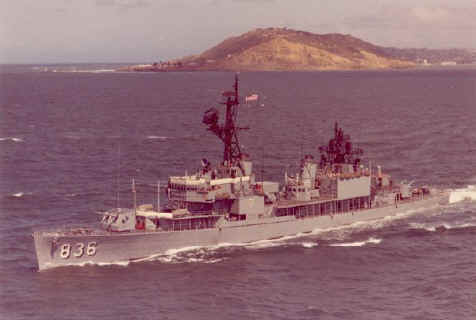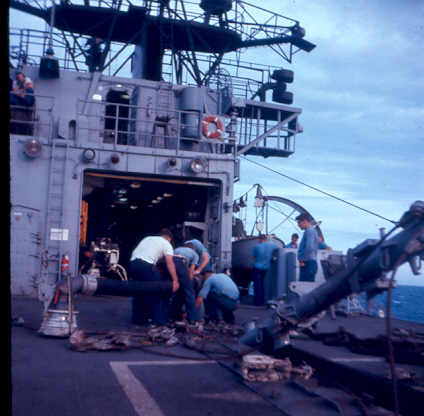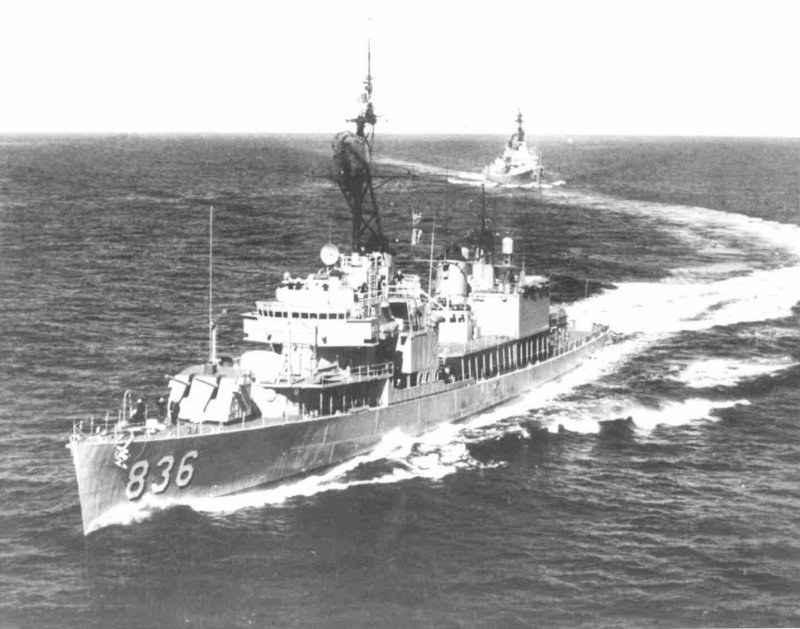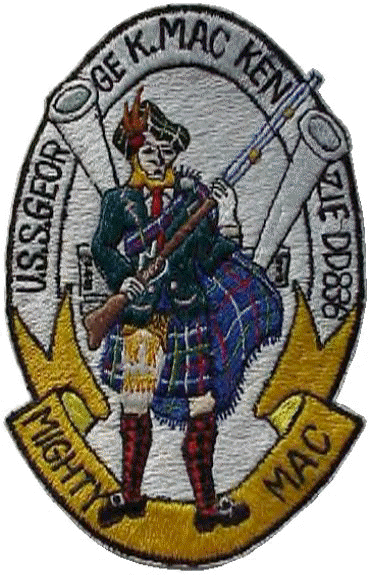|

Sir, the Sonar Dome is Flooded!
By Terry Miller, STG3 (Sonar Technician Third Class)
USS GEORGE K. MAC KENZIE (DD 836)
 Sailors
are famous, or perhaps infamous, for playing tricks on “boots,” or new
shipmates. Whether it’s sending them after some fictitious item such as “six
fathoms of water line,” or “relative bearing grease” or “a bucket of
steam,” the poor, unsuspecting newcomer just has to endure the initiation
because he can never get even with those who outrank him. He can only take it
out on those who follow. Maybe that’s the reason the tradition persists. Sailors
are famous, or perhaps infamous, for playing tricks on “boots,” or new
shipmates. Whether it’s sending them after some fictitious item such as “six
fathoms of water line,” or “relative bearing grease” or “a bucket of
steam,” the poor, unsuspecting newcomer just has to endure the initiation
because he can never get even with those who outrank him. He can only take it
out on those who follow. Maybe that’s the reason the tradition persists.
These
tricks run the gamut from simple one-on-one pranks to mass conspiracies
involving several members of a ship’s crew. As an example, on the George K.
Mac Kenzie DD-836, nearly everyone was in on the “Movie Watch” joke. The
scenario involved the junior-most engineering person in the duty section being
assigned to the “movie watch” which meant that he had to put on gloves and
sit next to the movie projector with a fire extinguisher between his legs for
the entire movie, you know, just in case the projector might catch fire.
In
1969 when the ship was about to come out of dry dock in Yokosuka, we picked up a
few crew replacements including E-3 Sonar Striker, Steve Cole. I was a Third
Class Sonar Technician and Steve was assigned to me. The day a ship comes out of
dry dock is a very busy one, with many duties that are only necessary at that
time. One of the things that happens when the water is pumped out of the dry dock
is that all the water in the Sonar Dome, the bulbous housing of the Sonar
Transducer at the bottom of the keel, drains out through an opening in the
bottom. Before the system can be reactivated, it must be refilled with seawater.
Every bubble of air has to be bled off because the first pulse of electric power
to all those ceramic piezoelectric elements in that transducer would cause them
to shatter if they transmitted into air instead of water. To prevent this, there
is a bleeding valve inside the ship along the keel at the top of the Dome that
is opened to allow the air to escape and the Dome to fill with seawater. Not
everyone knew this. In fact, very few sailors knew it. In absolute fact, one
fewer than I expected knew it that day.
As
the dry dock filled with water and the ship began to float again, ST1 Andy
Anderson told me to go flood the Sonar Dome in preparation for getting underway.
I told Cole to grab a bucket and a Crescent wrench and come with me. He hadn’t
heard the assignment so when he asked what we were doing, I told him we were
going to see if the Dome was flooded.
“What
if it is,” he asked?
 “Oh,
I’m pretty sure it isn’t flooded,” I told him truthfully. He didn’t ask
anything more until we
made our war to the very bowels of the ship where at last we reached the lowest
level where there was an oval plate secured to a bulkhead with 24 bolts. I had
Steve remove the bolts, holding the hatch up as he removed the last one. Moving
the heavy steel plate aside, I reached in and turned on the light, a bare bulb
hanging from its own cord in the middle of a tiny compartment just large enough
for one person to crouch inside. Coming up from the deck was a pipe, which led
up to a faucet with a built in hook for holding a bucket. I hung the bucket from
the hook and turned to Steve. “Oh,
I’m pretty sure it isn’t flooded,” I told him truthfully. He didn’t ask
anything more until we
made our war to the very bowels of the ship where at last we reached the lowest
level where there was an oval plate secured to a bulkhead with 24 bolts. I had
Steve remove the bolts, holding the hatch up as he removed the last one. Moving
the heavy steel plate aside, I reached in and turned on the light, a bare bulb
hanging from its own cord in the middle of a tiny compartment just large enough
for one person to crouch inside. Coming up from the deck was a pipe, which led
up to a faucet with a built in hook for holding a bucket. I hung the bucket from
the hook and turned to Steve.
“You
better hope we don’t hear air rushing out when I open this,” I told him with
my best poker face displayed.
“Will
that mean it’s flooded,” he asked in a hushed voice?
“It
will mean there’s water in the Dome.” Now, physics dictates that there is a
lot of water putting pressure on the air trapped in that Dome. I cracked the
valve slightly. A rush of air caused the bucket to sway.
“Oh,
man! It’s flooded! What do we do now,” he asked?
“Let’s
see if it’s just air or if there is water in there, too,” I told him. I let
the rest of the air out until water came bubbling into the bucket. I said
nothing but slowly shook my head, grim-faced A half- bucket later, the air
bubbles had stopped and there was nothing but water coming out of the spigot.
 “Now,
what,” Steve asked. I should have been sorry for what I did next. I really
should have. I wasn’t. “Now,
what,” Steve asked. I should have been sorry for what I did next. I really
should have. I wasn’t.
“Take
this bucket topside and pour it over the side then bring it back down here and
do it over until you get the thing drained. I’ll go report that it’s
flooded.”
I
never found out how long Steve worked at carrying buckets of ocean up four decks
and pouring it over the side before he caught on or someone told him. He was mad
at me for days. And as it turned out, I wasn’t quite finished with this prank.
I
went back to Andy and reported the assignment accomplished and he told me to
report it to our Division Officer, Mr. Teach, who was right outside Sonar
Control in CIC. Andy Anderson had one of the wiliest personalities in the Navy.
He didn’t have to say a word because I saw the unmistakable gleam in his eye.
Fooling one person with a practical joke can be humorous. Getting to another
with the same prank makes it hard to keep a straight face. I opened the door and
Mr. Teach was standing next to the plotting table a few feet away.
“Mr.
Teach, Andy wanted me to report that the Sonar Dome is flooded.” I delivered
this with no expression. I bit the inside of my lip as I saw the color drain
from his face.
“Are
you sure?”
“Yes,
sir. I verified it myself.” The effort to control the desire to laugh was
nearly painful.
“Come
with me.” He led the way down to the bridge where Lt. Breuer was Officer of
the Deck. Mr. Breuer was the Weapons Department head and a very savvy sailor. He
had the admiration and respect of the ship. He sensed the nearly palpable
anxiety in his junior officer. He gave me a quizzical look but waited for Mr.
Teach to report. Instead, Mr. Teach turned to me and said, “Tell Mr. Breuer
what you told me.”
“Sir,
I have to report that the Sonar Dome is flooded.”
“Did
you verify it personally?”
“Yes,
sir.”
“Very
well.” He started to turn away as he must have many times upon receiving a
satisfactory report. Mr. Teach started to say something, stopped, started again,
and stopped again. He looked at Lt. Breuer, then at me, then back at the
Lieutenant.
“I’ve
been had, haven’t I?”
Mr.
Breuer just smiled and turned to me and winked. I hurried away to keep from
laughing and to get back to tell Andy. I quit playing shipboard pranks after
that because there was just no way I’d ever be able to top it.

 

|
